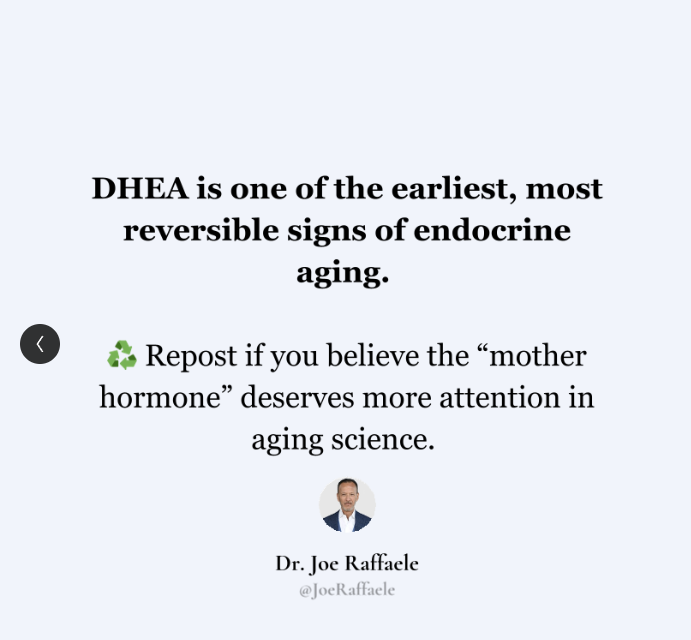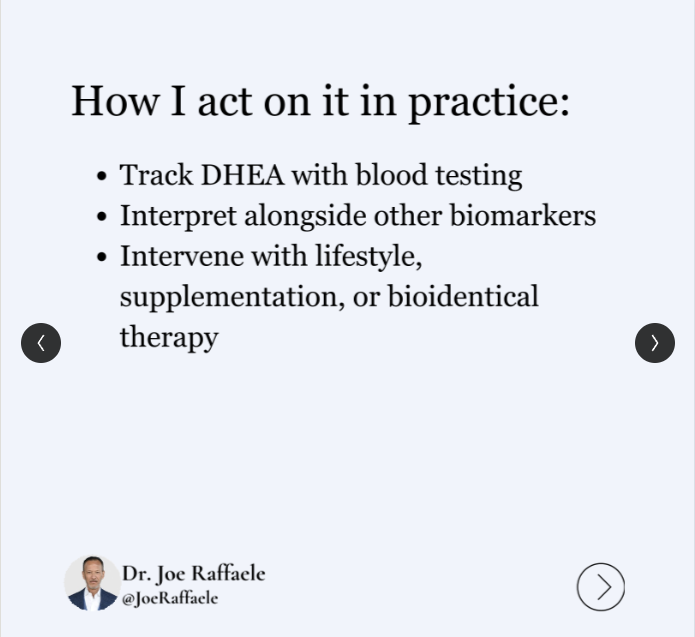
Joseph Raffaele: Everyone Asks Me About Testosterone. Few Ask About DHEA
Joseph Raffaele, Physician-Scientist in Longevity Medicine, shared a post on LinkedIn:
“Everyone asks me about testosterone.
Few ask about DHEA – but they should. Here’s why…

Sometimes nicknamed the “mother steroid,” dehydroepiandrosterone (DHEA), measured as its stable circulating form DHEA-S, is one of the most abundant hormones in the human body and one of the most overlooked in routine medical practice. Yet in the context of a longevity clinic, it deserves careful attention. From this single precursor, the body synthesizes testosterone, estrogen, and other downstream hormones.
DHEA levels peak in early adulthood and then decline steadily with age, often dropping by 80–90% by the eighth decade of life, leaving you more vulnerable to inflammation, metabolic dysfunction, and cardiovascular disease.
Compounding this natural fall, chronic stress accelerates DHEA depletion by tilting the adrenal balance toward cortisol production, leaving patients with a double hit of lower anabolic reserve and higher catabolic burden.
Why does this matter?
Because DHEA is not just a reproductive hormone precursor.
It is a pleiotropic regulator with wide-ranging effects:
– Cardiovascular Health: Higher DHEA-S levels are associated with better endothelial function, vascular elasticity, and reduced atherosclerotic risk. Low levels correlate with higher rates of cardiovascular events and mortality.
– Immune Function: DHEA enhances thymic activity, supports T-cell proliferation, and helps counteract the immunosuppressive effects of excess cortisol. Low DHEA-S is linked to frailty, impaired vaccine responses, and increased infection risk in older adults.
– Cognitive and Mood Resilience: Through neurosteroid activity, DHEA modulates neurotransmission and helps buffer against stress, depression, and cognitive decline.
How do we act on it?

In a comprehensive longevity practice, measuring DHEA-S provides actionable insight into both biological age and resilience. When clinically indicated, restoring DHEA to youthful physiologic levels via lifestyle optimization, stress reduction, or carefully dosed supplementation can be a cornerstone strategy to preserve vitality, cardiovascular integrity, and immune competence.
Longevity isn’t just about extending years, it’s about preserving function and quality of life.
Optimizing DHEA is one of the simplest, evidence-based steps to support both.
That said, there are a few caveats to be aware of. DHEA is comedogenic, meaning supplementation to restore healthy DHEA-S levels can sometimes trigger pimples or acne in those who are prone. A good approach is to start low, 2.5–5 mg daily, and increase in 5 mg increments only as needed.
In women, DHEA can also raise testosterone levels, since it is a key source of testosterone production in the adrenal glands.
If we ignore DHEA, we miss one of the most important predictive markers for extending healthspan.
Repost if you believe the “mother steroid” deserves more attention in aging science.”
Stay informed with Hemostasis Today.
-
Oct 6, 2025, 04:10EAHAD PT Committee Chair Ruth Elise Is Contributing to The Discussion On Joint Health and Mobility At EHC 2025
-
Oct 6, 2025, 03:44Caitlin Raymond: When We Talk About Plasma Exchange, Most Discussions Stop At What We’re Removing, But That’s Only Half The Story
-
Oct 6, 2025, 03:20Gianluigi Pasta On Cutting-Edge Cartilage Engineering for Bleeding Disorders Community at EHC 2025
-
Oct 5, 2025, 12:02Joseph Raffaele: Everyone Asks Me About Testosterone. Few Ask About DHEA
-
Oct 5, 2025, 11:58Dr Shamee Shastry and Team Establish New Insights on Critical Antibody Titers
-
Oct 6, 2025, 03:48New Insights On Pre-Existing AAV5 Abs in Haemophilia B Gene Therapy
-
Oct 6, 2025, 03:40Emmanuel J Favaloro and Leonardo Pasalic's Commentary On Acquired von Willebrand Syndrome in Children
-
Oct 5, 2025, 16:40Dr. Kalpana Gupta Shekhawat Insights About Leucovorin and how it Works on the Brain
-
Oct 5, 2025, 12:43Nita Radhakrishnan and Colleagues on Tertiary Prophylaxis with Extended Half-life Factor in LMIC Settings
-
Oct 5, 2025, 12:15Laura Avila and Colleagues on Childhood DVT: Upper Extremity (UE) Post-thrombotic Syndrome (PTS)
-
Oct 3, 2025, 15:31Anirban Sen Gupta and Andrew Shoffstall Collaboration on Bioinspired Synthetic Platelet Systems for Brain Injury Treatment
-
Oct 3, 2025, 15:07Shai Shen-Orr: Excited to Share that The Human Immunome Project (HIP) Has Launched Its Scientific Partner Network
-
Oct 2, 2025, 04:59Caterina Casari - Prizes for Innovators 2025 Winner!
-
Oct 2, 2025, 04:572025 Innovators Award: Ile de France Région Recognizes 3 Researchers Who Have Committed Themselves to The Innovation
-
Oct 1, 2025, 15:59Anirban Sen Gupta: Thrilled to share a great collaboration story in Nature Portfolio
-
Oct 6, 2025, 03:57Mattia Galli - Nominated Among The Top 200 of 200,000 Leading Researchers Worldwide for The 2025 USERN Prize!
-
Oct 6, 2025, 03:46Marilena Vrana: I Want to Thank Grifols Deutschland for The Opportunity to Visit Their Premises and Biotest AG Manufacturing Facility in Dreieich
-
Oct 6, 2025, 03:43Maha Othman: Real-World Learning Is Essential in Preparing Our Future Nurses!
-
Oct 6, 2025, 03:10Moath Albliwi to Present 4 Major Posters at 67th ASH Annual Meeting 2025
-
Oct 5, 2025, 12:29Miguel Crato: I Feel I Must Always Be Strong, But That Wears Me Down
